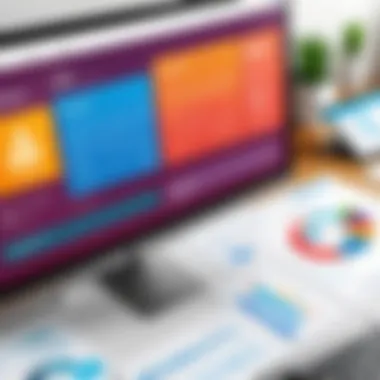In-Depth Analysis of AIA Billing Software Benefits


Intro
In the intricacies of the construction and contracting landscape, the complexities of billing often lead to inefficiencies and financial mismanagement. That’s where AIA billing software steps in, revolutionizing how professionals in the field approach their financial operations. Unlike traditional billing methods, which can be laborious and prone to error, AIA billing software offers streamlined processes that promise not just accuracy but also enhanced productivity.
As the construction industry tailors itself to ever-evolving technologies, understanding how to navigate these applications effectively becomes crucial. This article delves into the fundamental and advanced features of AIA billing software, its relevance, possible challenges, and the solutions that come with it. Whether you are a decision-maker looking to enhance operational workflows or an IT professional seeking to integrate this technology, the insights gleaned here will serve as a comprehensive resource.
Key Features and Functionalities
Comprehensive Overview
At its core, AIA billing software is designed to address the specific needs of the construction sector. One of the most compelling features of these software solutions is their ability to manage progress billing—this means that contractors can bill for work as it is completed rather than waiting until a project is fully finished. This functionality not only improves cash flow but also provides a transparent reporting mechanism for both clients and contractors.
Common features typically include:
- Automated Invoicing: Reduces manual inputs, minimizing errors.
- Customizable Bill Formats: Offers flexibility to accommodate various project requirements.
- Real-Time Project Tracking: Allows users to monitor project progress and financials simultaneously.
- Integration Capabilities: Seamlessly connects with other tools—like accounting software—to streamline processes.
Target Users
The user base for AIA billing software spans different roles within the construction industry, from project managers to accountants. The flexibility of the software allows it to cater to both small businesses and larger enterprises.
Key users include:
- Contractors: Who require detailed progress tracking and accurate billing.
- Project Managers: Looking to oversee budgets and timelines without falling behind.
- Accountants: Who desire precise financial data to facilitate reporting and audits.
Pricing Models and Cost Analysis
Breakdown of Pricing Tiers
Cost is a significant consideration when selecting AIA billing software. Different providers offer various pricing structures ranging from monthly subscriptions to one-time purchases. Understanding these pricing tiers can help organizations align their budgets accordingly. Some software may charge based on the number of users, while others may have fixed costs regardless of user count.
Typical pricing structures include:
- Basic Packages: Offering essential features at a lower price point.
- Standard Packages: Providing additional functionalities for medium-sized firms.
- Premium Packages: Including advanced features and support for larger enterprises.
Additional Costs to Consider
While evaluating options, it’s important to keep an eye out for hidden costs.
Some common additional expenses include:
- Setup Fees: Initial costs for implementing the software.
- Training Costs: If the solution is comprehensive, staff may require training to utilize it effectively.
- Customization Fees: For organizations that wish to tailor the software to their specific needs.
"When choosing AIA billing software, understanding the total cost of ownership goes beyond just the price tag. Factors like training and support can add up."
Epilogue
AIA billing software stands out as a vital component in the financial toolkit for construction professionals. It effectively simplifies an often complicated billing process while bolstering cash flow and financial accuracy. As this software continues to evolve, so do the businesses that employ it—driving efficiency and fostering better project management in the construction industry.
Preamble to AIA Billing Software
In the complex world of construction and contracting, financial clarity and accountability are of utmost importance. AIA billing software plays an integral role in achieving these goals. The essence of AIA billing lies in its capability to standardize the billing processes while adhering to the contractual guidelines defined by the American Institute of Architects (AIA). As projects unfold, the ability to accurately bill clients for the work performed leads not only to improved cash flow but also nurtures trust between contractors and clients.
Here, we delve into how AIA billing software has revolutionized the industry. Designed specifically to handle the unique needs of construction billing, it streamlines financial tasks that were often cumbersome and error-prone. Enhanced accuracy in billing not only mitigates disputes over payment but also promotes a seamless workflow from project initiation to completion. With the ever-evolving demands of construction projects, this software also enables users to stay compliant with regulations and standards.
Defining AIA Billing Software
AIA billing software is fundamentally a tool tailored for the construction industry. It assists contractors in preparing and submitting invoices that comply with AIA standards. But what does that really mean? Simply put, this software automates the billing process, which includes creating detailed pay applications, tracking expenses, and managing project budgets. With these functionalities, it eliminates a significant amount of manual labor typically associated with invoice preparation.
The key terminologies that often arise in the discussion of AIA billing software include:
- Pay Applications: Detailed accounts of work completed submitted for payment.
- Continued Contracts: Agreements that outline the phases of the project and corresponding payments.
- Change Orders: Documentation of adjustments to the original contract terms.
A clear understanding of these terms is crucial for users as they navigate the functionalities offered by the software.
Historical Context and Development
To fully appreciate the significance of AIA billing software today, one must consider its historical context. The early days of construction billing were characterized by an overwhelming reliance on paper-based processes and manual calculations. Errors were not only common but often led to delays in payment.


A significant turning point came in the late 20th century when the construction industry began adopting digital tools. As technology advanced, so did the solutions tailored for the AIA billing processes. Initially, simple spreadsheet templates were the go-to for many small firms. However, as projects grew in size and complexity, the demand for robust software solutions became evident.
The introduction of integrated AIA billing software marked a milestone, combining project management, accounting, and collaboration features into one platform. This evolution made it possible for developers and contractors to manage their financial processes with unprecedented precision. As compliance requirements intensified, so did the software’s capabilities, ensuring that users met regulatory standards effortlessly.
In summary, AIA billing software has evolved from a simple invoicing mechanism to a comprehensive solution that addresses the unique challenges posed by the construction industry. Its development reflects a broader trend towards digitization in the sector, which continues to drive efficiencies and improve outcomes in project management.
Importance of AIA Billing in Construction
AIA billing is like the backbone of the construction industry—essential yet often overlooked. Understanding its importance is key for stakeholders seeking to enhance financial efficiency and maintain compliance with industry standards. This section delves into the critical elements that underscore the significance of AIA billing in construction, highlighting how it streamlines financial processes and enhances accuracy and compliance.
Streamlining Financial Processes
In an industry rife with complexity, the need for streamlined financial processes cannot be overstated. AIA billing software simplifies tasks that typically involved countless hours sorting through paperwork or wrestling with spreadsheets. With automated invoicing, laborious manual entry becomes a thing of the past.
- Efficiency Gains: Busy construction firms no longer waste time tracking down paperwork or managing billing cycles ineffectively. Instead, invoices can be generated automatically and scheduled for delivery, allowing project managers to focus on what they do best—overseeing construction.
- Improved Cash Flow: By streamlining the billing process, firms can also accelerate cash flow. When invoices are sent on time and followed up with reminders, payment cycles shorten, which gives businesses the liquidity they need to keep operations running smoothly.
- Integration Across Boards: AIA billing software often integrates seamlessly with accounting software and project management tools, eliminating discrepancies between different systems. This holistic approach unifies financial data, making it easier for decision-makers to evaluate projects in real time.
"By automating billing processes, construction firms can unlock new operational efficiencies, simplifying oversight while bolstering cash flow."
Enhancing Accuracy and Compliance
Accuracy in billing is paramount, especially in a landscape as regulated as construction. Errors in billing can lead to financial loss or tarnished reputations, compelling the industry to adopt systems that enhance accuracy while ensuring compliance with AIA regulations.
- Accuracy in Documentation: AIA billing software often includes comprehensive document management capabilities. This functionality helps ensure that all necessary documentation, like change orders or contract amendments, are in sync with invoices. This prevents mistakes arising from miscommunication or lost information.
- Adhering to Standards: The construction industry has rigorous regulations that govern billing practices. Non-compliance can lead to hefty fines or delayed payments. AIA billing software keeps companies aligned with these standards by providing built-in compliance checks, ensuring that invoices are consistent with the contractual obligations.
- Data Analysis: The analytical tools offered by many AIA billing software solutions allow businesses to review past invoices, payment histories, and compliance metrics easily. This ability not only fosters accountability but also supports continuous improvement in billing practices within organizations.
Key Features of AIA Billing Software
The significance of understanding the key features of AIA Billing Software cannot be overstated. In an industry notoriously riddled with complexity and mismanagement, these functionalities serve as the backbone of a seamless billing process. Potential users need to grasp not just what these features entail, but also how they contribute to overarching business efficiency and financial accuracy. \n\nBy diving into aspects like automated invoicing capabilities, document management systems, integration with project management tools, and customizable reporting features, we can reveal how AIA billing solutions pave the way for smoother operations in construction and contracting spaces.
Automated Invoicing Capabilities
The heart of an effective billing system lies in its automated invoicing capabilities. These features eliminate the manual entry of invoices, reducing human error and accelerating the billing process. Imagine a situation where every month tedious invoices are manually compiled and sent to clients— it’s time inefficient and prone to inaccuracies. Automated invoicing takes care of this by generating invoices based on pre-established criteria and agreements, leaving no room for miscalculations.
\nAdditionally, many of these systems allow for scheduled invoicing which can be a game changer for cash flow management. Regular and timely billings ensure that cash flows are more predictable, which is crucial for maintaining a healthy operation. Furthermore, automated reminders and notifications can be set to alert clients as due dates approach—effectively reducing the instances of late payments.
Document Management Systems
In today’s fast-paced environment, the ability to effectively manage documents is vital. A comprehensive document management system within AIA billing software provides organized storage for essential documents such as contracts, invoices, and project agreements.
\nThese systems not only keep documentation in order but enable easy retrieval whenever necessary. For instance, when a dispute arises over a billing issue, having immediate access to relevant documents can make or break resolutions. Collaboration among team members becomes smoother as well since they can share and review documents without the clutter of physical files.
\n> "In a world where time is money, a well-oiled document management system pays dividends in efficiency and accuracy."
Integration with Project Management Tools
Another crucial feature is the software’s ability to integrate with project management tools. In the construction industry, where multiple stakeholders and processes are at play, this synchronicity is gold. When financial data naturally feeds into project management applications, it reduces the likelihood of miscommunication between teams.
\nThis integration allows project managers to link project budgets directly with billing, ensuring that every expense is accounted for, and financial forecasting can be more accurate. The collaborative efforts between billable hours tracked by project management and invoicing outputs streamline processes and provide clearer insights into financial health.
Customizable Reporting Features
Finally, customizable reporting features are key in data-driven decision-making. Every organization has unique needs and metrics it values most. AIA billing software that offers customizable reporting capabilities allows users to tailor reports to their specific requirements. \n\nInstead of sifting through generic reports, stakeholders can produce targeted data analyses—be it profit margins, outstanding invoices, or project budgets. This capability also aids in regulatory compliance, as comprehensive and accurate reports are necessary when undergoing audits or reviews.
\nUsers can design these reports to hit the highlights they care about, making it easier than ever to communicate results and forecasts to upper management or investors.
By honing in on these key features, decision-makers can see clearly how AIA billing software does not just serve as a tool for billing, but as a partner in driving operational efficiency and profitability in construction and contracting enterprises.
Choosing the Right AIA Billing Software
Selecting the appropriate AIA billing software is a decision that can significantly affect an organization's efficiency and financial health. In a world where technology is advancing at breakneck speed, the last thing you want is to be left trailling behind because of poor software choices. The right software not only streamlines billing processes but also enhances compliance with AIA standards, ensures accurate financial reporting, and supports long-term growth. This section delves into two pivotal areas: assessing organizational needs and evaluating feature sets and usability.
Assessing Organizational Needs
Understanding your organization’s unique needs is the first step in selecting the right AIA billing software. Each company operates differently; what works for a small contractor might not suit a large construction firm. Here are a few essential elements to consider:
- Current Processes: Map out your existing billing processes. Are they clunky? Do they create delays? Having clarity on these aspects can pinpoint what features you truly need.
- Team Input: Talk to your team members who deal with billing. They can offer firsthand insight into what’s lacking in your current system, helping you build a more user-friendly approach.
- Business Size and Scope: A small firm may not require the same feature set as a multinational construction corporation. Tailoring the selection process to the company scale helps avoid overspending or under-utilizing software.
- Budgetary Considerations: How much are you willing to invest? While expensive software may promise cutting-edge features, more affordable options may serve your primary needs just as well.
By assessing these fundamental needs, organizations can pare down their choices to software that best fits their operational requirements.
Evaluating Feature Sets and Usability
Once you have a clear understanding of your needs, the next step centers on evaluating the software options available against those needs. Here��’s how to approach this:
- Key Features: Look for essential features such as automated invoicing, customizable billing templates, integration with project management tools, and robust reporting systems. Each feature should align with the goals you aim to achieve with AIA billing.
- User Interface: Usability is equally paramount. The software should be intuitive, allowing team members to quickly adapt without extensive training. If it feels like rocket science, it's likely to hinder efficiency.
- Integration Capabilities: The ability to integrate with other systems currently in use is often overlooked. Whether it's accounting software or project management tools, smooth integration can enhance workflow and data accuracy.
- Scalability: As businesses grow, their software should too. Opt for a solution that can accommodate increases in volume without a significant overhaul.
Selecting the right AIA billing software, when done thoughtfully, can transform a tedious billing process into a seamless, coherent operation. The time taken in this initial assessment and evaluation phase often pays dividends in improved accuracy, compliance, and overall workflow.
“The right software is not just a tool; it's a strategic asset for your business.


User Dynamics and Interaction
Understanding user dynamics and interaction is crucial when examining AIA billing software. In a rapidly changing construction landscape, the effectiveness of software solutions largely depends on the relationships and interactions between end users and the technology they employ. This section dissects these dynamics to highlight their impact on operational efficiency, accuracy, and overall project success.
Role of Users in AIA Billing Processes
The role of users in AIA billing processes cannot be overstated. Users range from project managers to accountants, and their understanding of the software directly influences how effectively it is utilized. At the heart of this interaction is user engagement, which hinges on a few core elements:
- Training and Expertise: Users must undergo thorough training to grasp the software's functionality fully. A user who knows how to leverage every feature is better positioned to manage billing processes efficiently.
- Feedback Mechanisms: Involving users in the software development and improvement process is beneficial. Regular feedback helps developers tune the application to better meet user needs.
- Team Collaboration: AIA billing often involves multiple team members working together. Users from different departments must seamlessly share data, so cross-departmental familiarity with the software is key.
The interaction between users and AIA billing software can lead to better compliance with formats and standards mandated by the American Institute of Architects (AIA). When users grasp how to navigate billing procedures using the software, they help to minimize errors, enabling timely bill generation and improved cash flow.
Common User Challenges
Despite the advantages of AIA billing software, users often face a spectrum of challenges that can hinder effective interaction. Common issues include:
- Complexity of Software Features: Some users find themselves overwhelmed by complex features or options they seldom use, leading to frustration.
- Resistance to Change: Adapting to new tools can be difficult. Staff accustomed to manual processes may struggle with a full transition to digital systems, leading to declines in productivity.
- Integration Problems: Users frequently experience difficulties when integrating AIA billing software with other systems, such as project management or financial software. These hiccups can result in data silos and inefficiencies.
"User experience is vital. If employees are unhappy with how a tool operates, it doesn’t get used to its fullest potential."
In many cases, the disconnect between users and software stems from a lack of ongoing training or inadequate onboarding protocols. To maximize the benefits of AIA billing software, organizations must confront these challenges head-on, ensuring users feel supported and confident in their capabilities.
Comparative Analysis of Market Options
When it comes to selecting AIA billing software, a comparative analysis of market options is paramount. The landscape is teeming with various solutions, each one coming with its own set of features and benefits. By diving into this comparative assessment, decision-makers can make a well-informed choice that aligns with their unique organizational needs.
This section will delve into the top software currently making waves in the industry, looking closely at what makes each one tick—and where they might fall short. A solid understanding of the ins and outs of these solutions can be a real game-changer in navigating the complex requirements of construction billing.
Top AIA Billing Software Solutions
There are numerous AIA billing software options in the market today. Below are some of the standout players that are frequently recommended by construction professionals.
- Sage 300 Construction and Real Estate: This software integrates seamlessly with project management tools and offers excellent document management features. It’s particularly noted for its robust reporting capabilities.
- Viewpoint Vista: A cloud-based solution that provides extensive financial management tools. Its strong user community offers a wealth of shared experiences and resources.
- Procore: Known for its user-friendly interface, Procore provides a comprehensive suite that covers everything from billing to project tracking.
- Stack: This software allows for multiple project management and billing functions, boasting an intuitive design that is accessible for new users.
This list is by no means exhaustive, but it highlights some of the big players well-regarded in the industry.
Strengths and Weaknesses of Each Option
Evaluating the strengths and weaknesses of these top AIA billing software solutions helps in aligning the right tool with organizational objectives.
- Sage 300 Construction and Real Estate
Strengths: - Viewpoint Vista
Strengths: - Procore
Strengths: - Stack
Strengths:
- Offers comprehensive reporting tools
- Highly customizable
- Integrates well with other financial software
Weaknesses: - Steeper learning curve for new users
- Higher price point compared to other options
- Excellent customer support
- Strong tracking and reporting features
Weaknesses: - Can be too complex for smaller firms
- Some users report performance lags
- Intuitive user interface
- Comprehensive project management features
Weaknesses: - Costs can accumulate quickly with add-ons
- Limited customization options
- User-friendly design
- Great for on-the-go billing
Weaknesses: - Basic reporting capabilities
- May not meet all advanced billing needs
Understanding these strengths and weaknesses allows stakeholders to weigh their options against their specific requirements. It's not just about finding a software that sounds good—it's about finding the one that fits like a glove.
Implementation Considerations
Implementation of AIA billing software is not merely about software installation; it’s a crucial journey that shapes the future of financial workflows in construction projects. Getting this right can make or break – not just the efficiency of billing processes but also the broader organizational adaptability to agile practices in project management. Decisions made at this stage carry significant weight, influencing ongoing operations and user satisfaction.
Steps for Effective Implementation
When rolling out AIA billing software, a structured approach can mitigate risks and ensure a smoother transition. Here are some key steps:
- Assess the Current Workflow: Understanding how current processes operate helps in mapping out the new system’s integration. Identify bottlenecks and inefficiencies to target the enhancements effectively.
- Engage Stakeholders Early: Bringing in stakeholders from various teams fosters support and gathers insights that can shape the deployment. Without buy-in, you risk facing resistance down the line.
- Create a Detailed Implementation Plan: A roadmap with timelines, responsibilities, and goals serves as a guide. Ensure it outlines critical milestones that everyone can rally around.
- Data Migration: Transferring existing financial data into the new software requires due diligence. Clean, organize, and validate data to avoid discrepancies that could lead to compliance issues.
- Test the Software: Before going live, thorough testing lets you evaluate the software’s functionality. Look for bugs and gauge user-friendliness in real-world conditions to fine-tune settings.
- Launch and Monitor: Once the software is operational, monitoring its performance is vital. Collect feedback from users to identify areas for improvement.
Training and Onboarding of Staff
No software can work miracles without the right users. Training and onboarding play a pivotal role in maximizing the return on investment for AIA billing software.
Effective training ensures that users are comfortable and competent with the new system. Here are some considerations:


- Tailor Training Programs: Different roles within the organization may require distinct training sessions. Accounts payable staff might need in-depth data entry training, while project managers may benefit from an overview of the reporting features.
- Utilize Mixed Training Methods: People learn in various ways. Combine workshops, hands-on sessions, and online resources to cater to different learning styles. Videos, manuals, and FAQs can provide ongoing support.
- Encourage a Culture of Learning: Promote a supportive environment where employees feel safe to ask questions and share challenges. This culture can significantly influence the successful adoption of any new technology.
- Gather Feedback for Continuous Improvement: Post-training surveys can collect feedback to refine training materials. Users’ insights can be invaluable in creating a more effective onboarding experience.
Implementing AIA billing software effectively entails much more than technology; it necessitates a holistic view of organizational change. Proper planning and training pave the way for improved operational efficiency, leading to better alignment with industry standards and ultimately securing a competitive edge in the construction marketplace.
In the world of construction, effective implementation of billing processes can often spell the difference between profit margins and pitfalls.
Regulatory Compliance and Standards
The landscape of AIA billing software is intricately tied to the myriad regulations and standards that govern the construction industry. With the stakes so high in construction projects, understanding the role of regulatory compliance is vital for ensuring that all processes, including billing, run smoothly and transparently. Let's explore the nuances that come into play here and why they matter.
Understanding AIA Regulations
The AIA, or American Institute of Architects, has set forth guidelines that aim to standardize billing practices across the construction sector. These guidelines provide a framework that not only aids contractors in preparing accurate invoices but also helps in maintaining clarity among all stakeholders involved. AIA billing forms, such as the G702 and G703, are integral to this process, as they delineate the scope of work and financials in a clear, concise manner.
The regulations are not merely bureaucratic footnotes. Instead, they serve myriad purposes:
- Protect Stakeholders: By adhering to these regulations, companies protect themselves from potential legal disputes, fostering a trust that is essential for repeat business.
- Promote Transparency: Clear guidelines help ensure that all financial dealings are visible and understandable, which is paramount in avoiding misunderstandings among clients and contractors.
- Ensure Accurate Reporting: Following AIA standards assists in generating reports that reflect precise financial statuses, useful for audits and financial assessments.
However, compliance is not a one-size-fits-all affair. Each project can have unique requirements depending on its location, scale, and complexity, thus necessitating flexibility in understanding and applying these regulations.
Importance of Compliance in Billing
In the realm of billing, compliance is not just a regulatory checkbox; it proves to be essential for operational success. First and foremost, non-compliance can result in hefty penalties and a tarnished reputation, which can be harder to mend than a cracked foundation in a skyscraper.
The benefits of compliance in billing practices include the following:
- Minimized Risk: By adhering to established standards, organizations can significantly reduce the likelihood of disputes.
- Improved Cash Flow: Transparent billing processes streamline payment cycles, which in turn bolsters financial health and cash flow management.
- Enhanced Client Relationships: When clients receive clear and compliant billing, trust is fostered. They know what they’re paying for, thus enhancing the overall relationship between them and the contractor.
Compliance isn't just a hurdle to jump over—it's a cornerstone that paves the way for smoother interactions and financial clarity.
Future Trends in AIA Billing Software
The realm of AIA billing software is continuously evolving, reflecting the broader trends within the construction sector and the advancements in technology. It’s vital to keep an eye on these developments not just for staying relevant, but also for maximizing efficiency and profitability in project billing. The future of AIA billing software is compelling and multifaceted, intertwining aspects like automation, artificial intelligence, and evolving customer expectations.
Technological Innovations on the Horizon
In recent years, a slew of groundbreaking technologies has begun to influence how AIA billing software operates. One notable trend is the integration of artificial intelligence (AI), which helps in analyzing billing patterns and generating predictive analytics. This aids construction firms in foreseeing potential cash flow issues and adjusting their plans accordingly. Contrary to old-school methods, AI can dramatically shorten settlement cycles, allowing faster invoice processing and payment.
Another major trend is the use of cloud-based solutions. This innovation promotes flexibility and accessibility, allowing users to manage billing from any location. For instance, instead of being tethered to a specific office, teams can manage invoices and financial documents on-the-go, which is a game changer for remote project management. In the world where collaboration is key, having this capability cannot be overstated.
Moreover, the rise of mobile applications tailored specifically for AIA billing makes it simpler for stakeholders to review and approve invoices instantly. This transforms the entire billing process into a more dynamic and responsive operation.
Adaptations to Changing Industry Needs
The construction industry is notorious for its unpredictability and evolving requirements. As a consequence, AIA billing software must adapt in response to shifts like labor shortages, regulatory changes, and sustainability initiatives. Construction firms are becoming increasingly aware of the importance of sustainability, which means they are looking for software that not only meets their financial needs but also aligns with eco-friendly practices.
For example, some AIA billing software options are beginning to incorporate energy efficiency metrics that allow project managers to bill for sustainable practices. This makes it easier for firms to not only comply with regulations but also to promote their commitment to environmentally favorable methods.
Additionally, evolving client expectations play a significant role. Today’s clients demand transparency and real-time updates on project costs. As such, AIA billing software providers are integrating features that allow for real-time tracking of project costs, giving stakeholders immediate insight into the financial implications of their projects.
"In a world where construction projects can change on a dime, the capacity to swiftly adapt billing procedures can differentiate a successful project from a stalled one."
By keeping abreast of these trends, firms can ensure they are not just keeping their heads above water but are instead surfing the wave of innovation, leading the charge in operational efficiency and financial accuracy.
In summary, the future landscape of AIA billing software holds much promise. It is becoming increasingly intertwined with advancements in technology and frameworks that meet the urgent needs of the market, which in turn drives better project outcomes.
Finale and Recommendations
In wrapping up this exploration of AIA billing software, it’s crystal clear that the subject holds substantial weight in the realms of construction and contracting. The effectiveness of billing processes directly echoes through the entire operational framework of projects, impacting timelines, cash flow, and overall project success. Thus, making informed choices about AIA billing software is not just about picking a tool; it's about aligning with a system that can adapt to the unique demands of your organization.
Key Takeaways from the Analysis
After diving into the depths of AIA billing software, several crucial points stand out:
- Streamlined Processes: AIA software significantly improves efficiency by automating invoicing, reducing time spent on mundane financial tasks.
- Improved Accuracy: Addressing human error is vital. With automated systems, users minimize the risks of mistakes, which can lead to discrepancies in billing.
- Compliance Assurance: The software often comes with built-in tools that ensure adherence to industry regulations, safeguarding your organization from potential legal issues.
- Customizability: Diverse needs mean diverse solutions. The best AIA billing software allows for customization, ensuring it meets specific business requirements.
- User Dynamics: Understanding how different users interact with the software can help organizations tailor their training and implementation strategies effectively.
Final Recommendations for Stakeholders
As stakeholders consider transitioning to or upgrading AIA billing software, here are some actionable recommendations:
- Conduct a Needs Assessment: Before selecting software, identify the specific needs of your organization. A thorough understanding of current challenges will guide you toward a fitting solution.
- Evaluate Beyond Features: While features are significant, usability cannot be overlooked. Ensure that the chosen solution is user-friendly to facilitate quick adoption among staff.
- Engage in Training: Proper onboarding is essential. Provide comprehensive training for personnel to maximize the software's potential and reduce the learning curve.
- Stay Informed on Trends: The landscape of construction technology is always evolving. Regularly seek updates and improvements in your AIA billing software to ensure continued efficiency and compliance.
- Foster Feedback Loops: Encourage team members to share their experiences and feedback regarding the software. Continuous improvement often comes from understanding firsthand user challenges.
"Selecting the right AIA billing software is akin to choosing the right foundation for a building. A solid, well-considered decision will support all future endeavors effectively."















